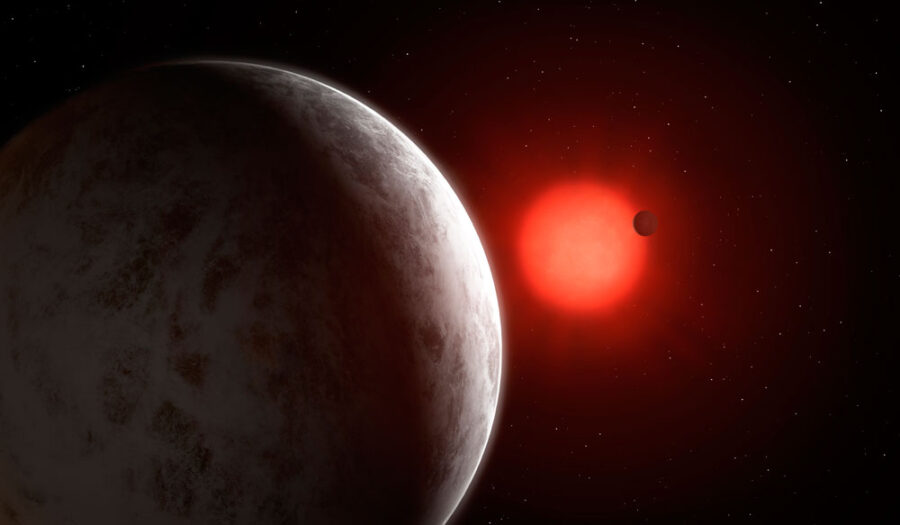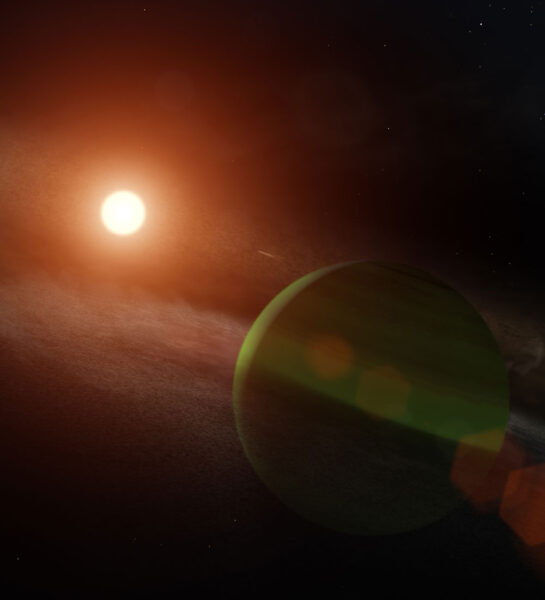A trio of nearby exoplanets make tempting new targets for next-gen telescopes.
Only nine light-years away, two super-Earths orbit a red dwarf star known as GJ 887. And just a bit farther away, at 31 light-years, another red dwarf — this one an infant still ringed in planet-forming material — hosts a Neptune-size planet.
This trio of just-discovered exoplanets, announced in this week’s Science and Nature, respectively, make promising targets. They are among the crop of nearby exoplanets whose atmospheres and compositions astronomers are likely to study first with next-gen telescopes.
Two Super-Earths (or Three?)

Mark Garlick
Sandra Jeffers (Georg August University of Göttingen, Germany) and colleagues discovered the family of super-Earths around GJ 887 as part of the Red Dots project. They aim to find exoplanets around nearby red dwarf stars by the slight back-and-forth motions of the star as it’s tugged by its orbiting planets.
Using the High Accuracy Radial Velocity Planet Searcher (HARPS) instrument at the La Silla Observatory in Chile, the team monitored GJ 887 for three months, capturing the signals of two planets: GJ 887b is at least four times Earth’s mass and 0.07 astronomical units (a.u.) from its star, circling it every 9 days. GJ 887c is even heftier, at least 7.6 times Earth’s mass. It completes an orbit every 22 days at 0.12 a.u.
Both planets’ paths easily fit inside Mercury’s orbit around the Sun, and they are inside their star’s habitable zone boundary. In the habitable zone, water might exist stably on a solid surface, but unless these planets have an atmosphere that can mitigate their star’s heat, they are likely too hot for life.
The researchers find hints of a third super-Earth that is within the habitable zone, but they’re unable to separate the signal from the star’s own fluctuations. “We regard the third signal at ~50 days as dubious and likely related to stellar activity,” Jeffers and colleagues write.
What nevertheless makes the system so intriguing is that GJ 887 is surprisingly steady for a red dwarf. Most such M-class stars bristle with magnetically fueled explosions and bright X-ray flares that could damage the chances for life on surrounding planets. But for whatever reason, observations show that GJ 887 is relatively inactive. “If someone had to live around a red dwarf, they would want to choose a quieter star like GJ 887,” writes Melvyn B. Davies (Lund Observatory, Sweden) in an accompanying perspective.
One Super-Neptune

NASA GSFC
AU Microscopii is an infant star, only 22 million years old, and still surrounded by a debris disk containing the building blocks of future planets. Within this disk, Peter Plavchan (George Mason University) and colleagues have discovered an already-formed giant, AU Microscopii b, with less than 3.4 times Neptune’s mass.
The debris disk appears edge-on, so it’s no surprise that Plavchan’s team discovered the planet by its transit across the face of its star, slightly and periodically dimming its light. The Transiting Exoplanet Survey Satellite (TESS) caught two of these transits, just missing a third due to an unluckily timed downlink, which interrupted data collection. (TESS will be re-observing this section of sky starting July 4th, so we can expect additional transits soon.)
“The transits are relatively deep and flatbottomed, and they are confirmed with the Spitzer data,” says Leslie Hebb (Hobart and William Smith Colleges), who was not involved with the study. “This definitely looks like the real thing, and it is super exciting!”
This Neptune-like planet has an orbit similar to GJ 887b, with an 8.5-day orbit from 0.07 a.u. What’s interesting about this planet is that it orbits in a large central space. The star’s dusty debris disk lies farther out, extending from 35 to 210 a.u., like an extended Kuiper Belt. So there’s no more gas for AU Mic b to collect, and it’s therefore probably finished growing.
In fact, it might actually lose mass due to the star’s intense UV radiation. “In a billion years, maybe the expected thick hydrogen and helium atmosphere will be gone, leaving behind the rocky core,” Plavchan says.
There’s a good chance this planet actually formed farther out and then migrated inward to its present location, interacting with the debris disk until the disk disappeared. “Since this planet is so young, we know it's atmosphere is ‘primordial,’” Plavchan says, “so it will be very interesting to learn what its atmosphere is made of to understand the planet formation process.”
While none of these planets are likely to be habitable, their proximity nevertheless makes them prime targets for follow up not only with existing instruments but with next-gen telescopes that can better probe their atmospheres and compositions. NASA’s James Webb Space Telescope is due to launch next year, the European Space Agency’s ARIEL mission is set for a 2028 launch, and extremely large ground-based telescopes should come online within the decade. These future observatories should give us a closer look at the planets’ atmospheres and composition.
 0
0









Comments
You must be logged in to post a comment.